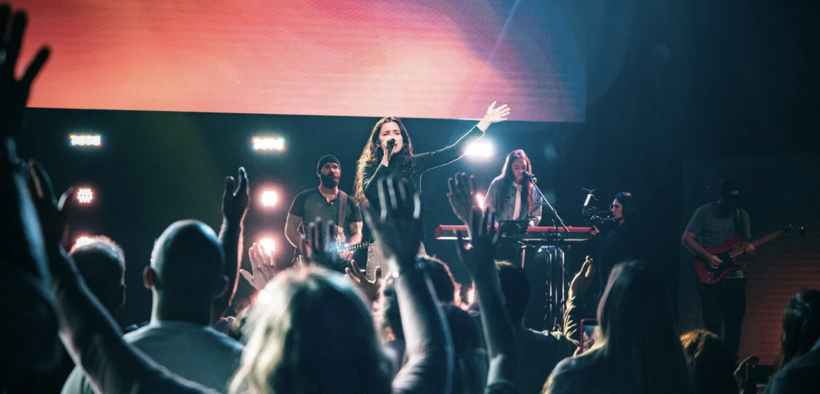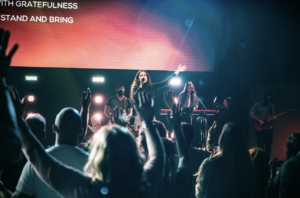Big Churches Sound Alike. Little Churches are the ‘Wild West’ of Music, Study Finds.
Worship professor Will Bishop said that focusing on the most popular worship songs can miss what churches are actually singing

(RNS) — Step into a big Baptist church on Sunday morning and chances are you’ll hear the same popular worship songs played at other big churches around the country.

Photo by Nathan Mullet / Unsplash / Creative Commons
But show up in a small church, and you never know what you’ll find — anything from “How Great Thou Art” to “Take Me Home, Country Roads.”
“Smaller churches are like the Wild West,” said Will Bishop, associate professor of church music and worship at Southern Baptist Theological Seminary in Louisville, Kentucky. “Anything goes.”
Bishop has been working on a recent survey project to better understand the worship music used in local churches, especially smaller congregations, in the nation’s largest Protestant denomination.
He said companies like Christian Copyright Licensing International — better known as CCLI — do a good job tracking the most popular songs used in churches. But they often miss out on some of the details of worship in local congregations — such as who is picking songs or who plays them. They also miss when churches sing out of hymnals or other songbooks, rather than projecting songs on a screen.
The charts can also leave the impression that the only songs being sung in worship are hits from Hillsong, Bethel and other megachurches.
That’s true in big churches, he said, but not everywhere. Music at big churches is often put together by full-time staffers who have time to track down all the latest songs and follow the latest trends.
“They’re all going to the same conferences; they’re all kind of hanging out with the same people,” he said. “If you’re in a small church, you may not have any connections. You’re not going to conferences. You may not know what’s going on in the bigger world.”
Access to MinistryWatch content is free. However, we hope you will support our work with your prayers and financial gifts. To make a donation, click here.
Bishop said he started working on his survey to help his students know what to expect when they start working in churches. He sent surveys to more than 900 congregations in five different parts of the country: Louisville, Memphis, Oklahoma City and New York, along with rural Colorado and Louisiana.
He eventually collected data from 127 congregations — not a representative national sample, but enough, he said, to give a snapshot of the worship life of local churches. He asked details, like who picked songs, whether churches sang contemporary songs or hymns, whether some songs were banned, as well as asking for a church’s favorite hymns.
Among the findings:
About 1 in 5 churches sang more hymns than modern songs, while a third sang as many hymns as modern tunes. Four in 10 sang more modern songs than hymns. Only 1 in 10 sang mostly modern songs, while the same percentage sang mostly hymns.
Worship leaders pick most of the music, often with no input from the church’s pastor. Almost every church (89%) projects lyrics on a screen, while two-thirds of churches (65%) said they never use hymnals. One in five said women were not allowed to lead worship singing.
About 90 of the churches had banned at least one song: most often songs from charismatic megachurches Bethel and Hillsong. One church banned any songs written by popular worship artist Chris Tomlin, while another banned the popular anthem “How Deep the Father’s Love for Us.”
Bishop also asked churches to list their favorite hymns, then compiled a list of the most popular contemporary songs. The top song was “Living Hope,” co-written by Phil Wickham, a well-known worship artist, followed by the modern hymn “In Christ Alone,” and then three older hymns: “It Is Well with My Soul,” “Amazing Grace” and “How Great Thou Art.”
The resilience of hymns can get overlooked if you just look at the top 20 charts of worship songs, said Bishop, which mostly feature new songs.
“Hymn singing is not dead,” he said. “At least among Southern Baptists.”
At Owingsville Baptist Church in Owingsville, Kentucky, services feature a mix of contemporary songs and older hymns, said Waynanne Caudill, who helps lead singing on Sundays.
Services usually start with a contemporary song, like “Living Hope,” and there’s often another contemporary song before the sermon. The pastor often picks those songs, said Caudill, hoping newer songs will appeal to younger families in the congregation. Church members will also sing four or five hymns.
Despite being a small-town church — Owingsville has one stoplight and a Walmart, said Caudill — about half the church, which draws around 50 people, is made up of younger folks.
Caudill says she likes the mix of hymns and more modern songs — even though she’d prefer to sing songs by older Christian artists like the late Rich Mullins and the late Keith Green. She’s OK with more modern songs — but the Hillsong hit “Oceans” never sat right with her.
“The song says I’m going to walk on the water and most days I’m really not,” she said. “And that has weighed on me. You know, I want some more real stuff.”
Her favorite: “Oh, Lord, You’re Beautiful,” by Green.
Bishop’s survey is based on an influential 1938 study that helped shape Southern Baptist church music in the 20th century. Published in 1939, that study used survey techniques popularized by George Gallup to gather data from 1,093 local congregations.
That survey found most churches (83.7%) used a piano for services, while 18% had reed organs — also known as pump organs — and relatively few (4.8%) had pipe organs. One in 20 (4.8%) had no instruments at all.
About half of the churches spent no money on their music programs in 1938, and few had trained professionals on staff. Music was led most often (58.8%) by a male quartet, while 6.95% of churches had orchestras.
Several smaller surveys found that about a third of churches had choirs (1952) and that large churches were more likely to have a full-time janitor than a minister of music (1956).
Bishop’s new survey found that today almost three-quarters (72%) of churches have a worship band, while just over a third (36.5%) have an adult choir. However, only 7% have a junior choir, which he saw as a worrisome sign that churches weren’t investing in the future of their music programs.
The 1938 survey also included a list of favorite songs among churches. The most popular song was “What a Friend We Have in Jesus,” followed by “I Am Thine, Oh Lord,” “Standing on the Promises,” “Have Thine Own Way” and “The Old Rugged Cross.”
“What a Friend We Have in Jesus” didn’t make the list of most popular songs in Bishop’s survey, but several others that appeared in the 1938 list remain popular, including “Amazing Grace,” “The Old Rugged Cross” and “Holy, Holy, Holy.”
Martin Cherry, an associate pastor and worship leader at Flatonia Baptist Church in Texas, said the congregation often sings “What a Friend We Have in Jesus” and other older hymns during services, though with a more modern arrangement. The church had been mostly traditional till about a decade ago and slowly transitioned to more contemporary music.
Cherry said he and other leaders try to pick songs that fit the church’s identity, rather than trying to copy the latest trends.
“When churches try to push too hard, in different styles of music, it’s like asking your people to put on a costume, pretending to be something you’re not.”
He said “What a Friend We Have in Jesus” feels more relevant in the COVID era, given how isolated and divided people feel.
The church tried singing “Living Hope,” which is popular in other churches, but it just didn’t take.
Bishop’s survey did include some surprising results. He’d heard that some churches will play secular songs in services and decided to ask if that was the case. Some of the responses seemed to fit in church, like Carole King’s “You’ve Got a Friend” and Bill Withers’ “Lean on Me.” Others, like “The Lion Sleeps Tonight” and “Take Me Home, Country Roads,” left him scratching his head.
If a church really was doing a singalong of the John Denver hit during services, “I’d like to see a video of that,” said Bishop.



